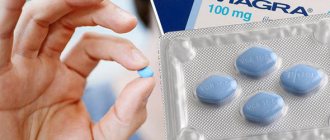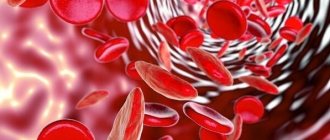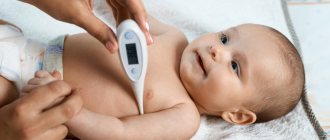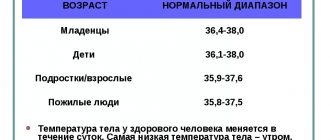Local therapist
Serebryakova
Oksana Evgenievna
Experience 26 years
Local therapist, candidate of medical sciences, member of the Russian Scientific Medical Society of Therapists
Make an appointment
High temperature is an unpleasant symptom, characteristic of many diseases, and a sure indicator of the presence of a disease. Reducing the reading to normal does not mean being cured, and you also need to know what temperature to lower. It is necessary not only to achieve a decrease in temperature, alleviating the patient’s condition, but also to eliminate the source of the inflammatory process.
To effectively fight the disease, you need the help of a qualified doctor who will determine the cause of the condition, which manifests itself:
- with chills of varying severity;
- feeling of loss of strength;
- headache, aches and pains;
- increased sweating;
- arrhythmia;
- loss of appetite;
- dry lips and skin.
The concept of normal for body temperature
Normal body temperature is considered to be 36.6°C, but this figure can fluctuate. The lowest value is observed in the morning, the maximum in the evening. An increase in temperature is facilitated by eating, drinking alcohol, exercising, stimulating the nervous system, being under the sun, or in a steam room. It is considered normal if a person’s temperature is 36.2°C in the morning and 36.7°C in the evening. A peculiarity of the female body is that the temperature decreases a few days before ovulation and increases when ovulation occurs.
The norm for an adult is considered to be between 35°C and 37°C, for children under 3 years of age – up to 37.5°C. In summary, a temperature of 35°C should not cause panic.
How to measure temperature:
- if you measure under the armpit, then a value of 36.6°C is considered normal;
- if in the mouth, then the indicator is half a degree higher;
- if in the rectum, then to get the result subtract 1 degree from the value on the thermometer.
The range from 37.1°C to 38°C is considered to be above normal. If low-grade fever persists for a long time, measures must be taken. An indicator of 38.1°C is already a high temperature that requires urgent help for the body.
Increased temperature in newborns
Separately, it should be said about the increase in temperature in newborns and children in the first year of life.
Immediately after birth, the child’s body is completely ready for independent thermoregulation. Newborns have sufficiently developed sweating and the ability to perform vasomotor reactions. However, an imbalance between heat production and heat loss develops more often in infants than in later life. In the first year of life, due to insufficiently expressed subcutaneous fatty tissue and a relative increase in the specific surface area of the body, the process of heat transfer always predominates. An additional increase in heat generation occurs in newborns due to increased oxidative processes in brown adipose tissue (non-contractile thermogenesis). They do not have contractile thermogenesis (the ability to increase heat production due to involuntary muscle contraction). Within 24 hours after birth, children exhibit the ability to develop fever, but at first it is less pronounced than at an older age. Therefore, infectious diseases in infants may not be accompanied by a significant increase in body temperature, but if this occurs, it indicates the severity of the disease [8].
Why is it dangerous when the temperature rises above 38°C?
If a high temperature occurs, then this is a sure sign of a sharply worsening pathology. In 99% of cases this is an inflammatory process. If the condition is long-term, it means that the malfunction in the body is serious, so you cannot do without qualified medical care. The patient's body reacts to the infection by stimulating the immune system, accelerating metabolism, producing antibodies, and increasing blood circulation.
At this time, microbes lose activity, but the respiratory and cardiac systems bear an increased load. The nervous system takes a hit, the body loses water. If the condition does not change, the temperature remains, then blood circulation in the internal organs will deteriorate. The most dangerous stage is when the indicator rises above 41°C. Before the doctor arrives, the patient must take antipyretics for fever.
Why is the temperature rising?
Sometimes it seems that a fever appears for no reason. But any inflammatory process can cause this condition. Inflammation can occur due to fungi, viruses, and bacteria. Often, a temperature of 38.5°C is a concomitant symptom, for example, with pain in the ear or throat, against the background of signs of ARVI. Patients are frightened by asymptomatic fever, which is observed:
- at the early stage of influenza, ARVI - when there are no catarrhal signs yet;
- with a sore throat - simultaneously with a sore throat;
- with chickenpox – in the first 2-3 days of illness a fever appears and then a rash;
- with an abscess - in the fight against pus, temperature peaks are replaced by normal values during the day;
- for glomerulonephritis, pyelonephritis - for inflammation in the kidneys;
- with appendicitis - often without pain;
- with hemorrhagic fever - with the bite of wild animals, muscle pain, rash;
- with encephalitis, meningitis - simultaneously with tension in the neck muscles, if it is impossible to lower the chin to the chest, pain in the head, blurred vision, nausea.
Which pill to choose?
This issue is decided by the doctor individually, depending on the age and concomitant diseases of the patient, as well as the severity of the infection.
For example, one patient may be prescribed ibuprofen, but this medicine has many contraindications. In particular, it should not be taken by patients suffering from gastrointestinal disorders, as well as elderly people, since against the background of a viral infection, their risk of bleeding may increase. As for aspirin, for this infection aspirin should not be prescribed under any circumstances.
Question answer
Why do electronic thermometers make mistakes so often? For high temperatures caused by COVID-19, the best choice, according to WHO, is paracetamol. It has an antipyretic and analgesic effect and is approved for use even in children (over 1 month), as well as pregnant and lactating women. Despite the fact that paracetamol has low toxicity and has fewer side effects than other antipyretics, this cheap and over-the-counter medicine should be taken very seriously. After all, its overdose threatens with dire consequences: the liver, kidneys, gastrointestinal tract, blood, heart, brain can be seriously damaged, and coma and death can even occur.
What should you do if you notice a symptom?
If the patient is either cold or hot, what to do with the temperature? When he gets chills, he should cover himself with a blanket, and when it gets hot, put on dry, light clothes. You can cover yourself with a sheet. The patient's main regimen is bed. If the child does not want to lie down, make sure that he does not engage in too active games, preventing the body from overheating.
It is necessary to ensure that the air in the room is periodically renewed. While airing, the patient can go to another room. You need to constantly replenish fluid reserves in the body by gradually drinking green tea, diluted juices, fruit drinks, and compotes. Water procedures cannot be taken; only wiping adults with a solution of water and vinegar 9% in a 1:1 ratio is allowed. Rubbing yourself with alcohol or cool water can make your fever worse.
Urgently call an ambulance for chills
If the temperature becomes high, it is recommended to call an ambulance in the following cases:
- headache and temperature above 38.5°C, drowsiness, lethargy;
- stomach pain and fever, especially if there is also vomiting and diarrhea;
- rash;
- convulsions, other severe conditions;
- lack of effect from taking antipyretics;
- overcoming the mark of 39.5 °C.
The ambulance service of JSC "Medicine" (clinic of Academician Roitberg) in the Central District of Moscow provides medical assistance around the clock in case of emergency. An urgent call to the team can be made by calling +7 (495) 229-00-03.
When should you go to the doctor?
If fever and blood pressure, cough, and aches appear simultaneously, you should not self-medicate. It is recommended to make an appointment with a doctor. JSC "Medicine" (academician Roitberg's clinic) in the center of Moscow invites you to use the services of experienced therapists who will diagnose the disease and prescribe the correct treatment. You don’t want to put your health at risk, so make an appointment immediately to prevent complications from developing! The clinic has a modern diagnostic department, laboratories for testing, and a hospital. If the need arises, a full range of medical services can be obtained without leaving the clinic.
Flu and fever
When describing the characteristic signs of influenza, patients and medical workers first of all note high temperature as a typical symptom of the disease: it quickly “grows” to high numbers and persists even against the background of antipyretic drugs. “What a shame - I’m sick!” - a workaholic with aching muscles, headache and severe weakness may exclaim. He will exclaim and begin feverishly to “bring down” the temperature using any available means in order to get rid of the infection in 2 days and continue to perform work feats.
He does not yet know that Canadian scientists have already conducted a study on the massive use of antipyretic drugs during the flu epidemic. And they came to the conclusion that such “treatment” only contributes to the spread of infection. Why?
Yes, because any person infected with the flu begins to spread the virus. But if he stops closely communicating with other people, takes sick leave and begins treatment, then the likelihood of “sharing” the virus decreases. The workaholic continues to lead a normal life and thinks that he was able to “deceive the system.”
Fever is a natural reaction of the body in response to infectious (bacteria, viruses) or non-infectious causes. The mechanism of hyperthermia is associated with an increase in heat production and limited heat transfer. The hypothalamus, adrenal glands, and thyroid gland play an important role in regulating body temperature. Its increase against the background of infectious diseases occurs due to the action of pyrogen substances, which are the decay products of viruses or bacteria, and body proteins.
The classification of fevers is based on the degree of increase in body temperature:
- subfebrile - temperature up to 38 ° C;
- febrile - temperature from 38 °C to 39 °C;
- pyretic - temperature from 39 °C - 41 °C,
- hyperpyretic - the temperature exceeds 41 °C.
Fever during influenza is subjectively difficult to tolerate, but it speeds up the basal metabolism by 1.5 times and activates the body’s defenses:
- stimulates antibody synthesis;
- inhibits the reproduction and spread of the virus;
- enhances the bactericidal properties of blood;
- accelerates the neutralization of toxins by the liver;
- activates kidney function.
Explaining how the body fights the influenza virus, infectious disease specialists note that an increase in temperature to 38-38.5 °C is “sufficient” to activate defenses and begin to destroy the infection. With such values, adults and children, as a rule, cope with the manifestations of the disease themselves and do not need to take antipyretics. Virus replication is stopped. Against the background of high temperature, the vessels dilate, and more immunoglobulins come to the site of infection with the blood. These are proteins that “pick up” infectious agents and, as part of immune complexes, are removed from the body. This way a person gets rid of the flu virus faster and recovers.
An increase in temperature to 39 °C or more can already cause harm to the body - the nervous, respiratory, and cardiovascular systems suffer.
Symptom treatment
To figure out how to bring down the temperature, you need a correct diagnosis. An experienced doctor, based on the results of tests and studies, determines the cause of the fever, prescribes medications, procedures, or refers to a specialist for additional research. The goal is to identify the source of the inflammatory process in order to find the right treatment complex. Treatment for high fever depends entirely on the underlying cause and may include antipyretics, antibiotics, probiotics, etc.
Symptom during pregnancy
The temperature in pregnant women rises above the normal limit due to acute respiratory viral infections and influenza. It can harm the baby, especially if the mother takes medications containing aspirin. Therefore, pregnant women with fever need urgent consultation with a doctor to prescribe the correct dose of medications. If the temperature jump is small, you can take homeopathic remedies prescribed by your doctor.
Along with the tablets in the 1st trimester, you can drink herbal teas, fruit drinks, compotes, and juices. At later stages, drink concentrated herbal infusions, which are not consumed in large quantities to avoid swelling. Decoctions of leaves, raspberries, coltsfoot, plantain, and infusion of white willow bark have healing properties. Rubbing with a vinegar solution helps.
Treatment at home
If you find cold symptoms and a temperature above 37°C and weakness, you can start taking home remedies to support the body. If the value on the thermometer does not exceed 38.5°C and the body feels more or less well, there is no need to lower the temperature. At this time, harmful bacteria die, and the immune system works at full capacity.
However, if the patient’s condition is serious, he does not tolerate the temperature well, it needs to be brought down. At 40°C the blood begins to thicken and coagulate, so you should take antipyretics. In order not to cause negative effects on internal organs, many patients prefer folk remedies with a mild effect.
Folk remedies for fever for children:
- children's enemas with a soda solution (1 tsp of soda for 1 glass of water) or chamomile decoction;
- wipe the child’s body with green grape juice;
- put on socks moistened with a solution of water and vinegar in a 1:1 dilution for 15 minutes;
- Infants and children under 3 years of age can be briefly wrapped in a wet sheet or towel to relieve the condition.
If the temperature is 39°C or 40°C in adults, it must be brought down:
- wiping and a cold compress - a cotton cloth is moistened with water at room temperature or a solution of water and vinegar;
- drinking plenty of fluids - it is necessary to prevent dehydration of the body by taking drinking water, freshly squeezed juices or warm herbal infusions, honey water (1 tsp of honey for 1 glass of warm water);
- fasting - give the body a rest (food is a load), concentrate energy on fighting inflammation.
How often can you take an antipyretic?
The question of how often you can lower your temperature with antipyretic drugs is relevant. These medications can cause significant harm to the body if used haphazardly.
It is acceptable to give to a febrile patient in age-specific dosages:
- paracetamol - 3-4 times a day;
- ibuprofen - 3 times a day;
- ibuklin, which contains both paracetamol and ibuprofen, 3 times a day;
- analgin - 2-3 times a day;
- aspirin, which is now not popular because it has many side effects, is allowed to be taken by adults and children over 12 years of age 3-4 times a day with an interval of at least 4 hours.
You cannot take antipyretic drugs in courses.
When does a temperature of 37.5 to 38°C occur without symptoms?
Temperature without symptoms in the range between 37.5-38°C is observed:
- for problems with the thyroid gland;
- tuberculosis;
- allergies;
- neurological diseases;
- oncology;
- pneumonia;
- gastroenterocolitis;
- viral hepatitis A.
Do not forget about such serious diseases that occur with an increase in temperature, such as:
- systemic lupus erythematosus, rheumatism, other autoimmune processes;
- endocarditis, myocarditis;
- syphilis, gonorrhea, genitourinary infections;
- rubella, measles, other viral infections.
How to shoot down?
When it becomes necessary to bring down the temperature of an adult, they use different methods, but it is better to combine them.
It is allowed to wrap the patient only in the first stage of fever, accompanied by chills.
In the stage of high temperature, a person needs to undress as much as possible, leaving only natural underwear. This will increase heat transfer and help cool you down.
Non-drug methods for relieving fever also include:
- Wiping the patient's skin with slightly warm water. Particular attention should be paid to places where large vessels pass. As the skin dries, the rubbing is repeated.
- Applying a cold compress to the forehead.
- Using an ice pack.
- Drink plenty of non-hot drinks: berry fruit drinks, water - little by little, but often.
Medication methods involve the use of:
- paracetamol;
- ibuprofen;
- analgin;
- aspirin.
If there is a persistent increase in temperature that cannot be lowered on an outpatient basis, you need to call an ambulance for injection of medications, consultation and possible hospitalization.
What to do if a fever appears after vaccination?
Fever after vaccination is not always a complication. Often its appearance is a normal reaction of the body to a foreign body, pathogens. The immune system receives a load and intensifies the fight against the disease, which occurs in a mild form. How the body will react to the introduction of substances, no physician can make an accurate prediction. Not everyone gets sick after vaccination.
You should remember about contraindications to vaccination and do not vaccinate during or after suffering from infectious diseases, exacerbations of chronic diseases, allergies, complications from previous vaccination, and other cases that your doctor will remind you about. For a full consultation, you can contact JSC “Medicine” (clinic of academician Roitberg).
How and why to measure basal temperature?
Basal temperature is measured at the moment of awakening. It helps determine the day of ovulation to plan conception and try to determine the sex of the unborn child. Basal thermometry is carried out in the first minutes after sleep, before physical activity. The oral cavity, rectum, and vagina are suitable for measurements. The gynecologists of JSC “Medicine” (clinic of academician Roitberg) in the Central Administrative District will tell you more about the methods for determining the day of ovulation. After consultation, you will be able to plan your pregnancy down to the day, and also try to influence the gender of your unborn baby.







